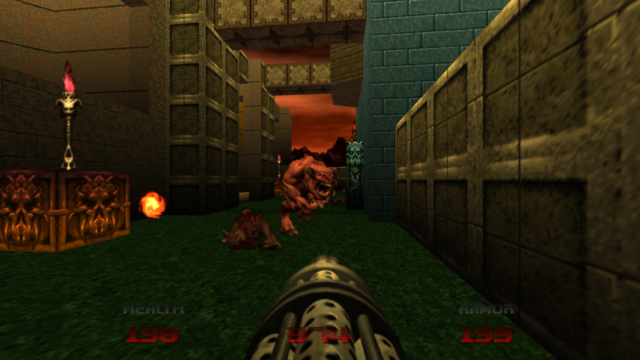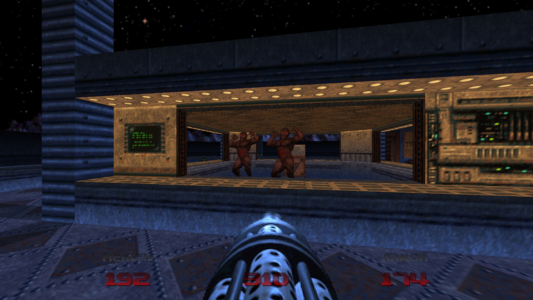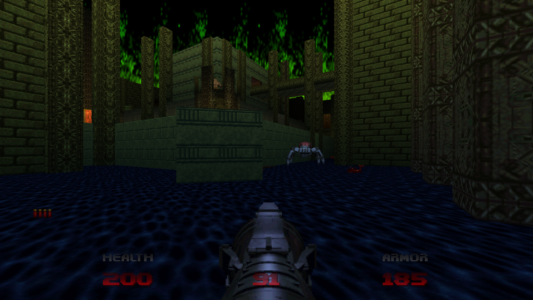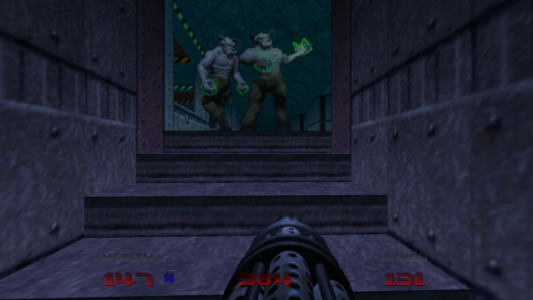
Doom 64
Written by: Stoo
Date posted: March 23, 2023
- Genre: Action
- Developed by: Original N64 version by Midway Studios San Diego. Re-release created by Night Dive Studios
- Published by: Bethesda Softworks
- Year released: 2020
- Our score: 9
Strictly speaking, today’s item doesn’t qualify for review here. It’s old, and it’s on the PC, but it’s not an “Old PC game”. Instead it’s a relatively recent port of something released for a console back in the 90s. Yet I’d hope we can all agree that it warrants an honorary place here.
We start with the original Doom, probably the single most important game in the early years of first person shooters. Building on the tech of its predecessors, the clever code from the guys at iD could render more realistic pseudo-3D environments, whilst still moving at a high clip. This meant intense, visceral action of a sort that gamers had never before encountered. We were dashing through abandoned mars bases and outposts on the shores of hell. Firing rockets into hordes of imps. Circle strafing cacodemons while hammering them with the chaingun. Desperately shoving the chainsaw into the faces of snarling demons. Limping towards the end of a map, down to 22% health only to find ourselves facing down the dreaded Hell Barons. It was relentless, wonderful carnage.
Doom then was a masterpiece: critically acclaimed, hugely popular, and highly influential. In fact for a few years we were referring to games that followed it as “Doom clones”. Or at least, PC Zone magazine was, but for both of us here that was basically our gaming bible anyway. I could write more of an analysis, but if writing this keeps me up until 3am I will regret it, so you could go read Rik’s review. Particularly useful, I think, because he’s coming at it from a perspective outside of the game’s hardcore fandom.
It also got ported to a bunch of consoles, which strikes me as a good example of how the wider gaming landscape was changing. For years the PC was a boring beige box for spreadsheets. We MS DOS nerds enjoyed RPGS and flight sims but looked wistfully at the lineup of traditional 2D action games on consoles. Occasionally we’d get a port of varying quality. Well now the PC, with its burgeoning hardware power, was spearheading a new wave of 3D action games. Consoles would get some home-grown shooters of their own soon enough, but in the early days a decent chunk of their selection were ports of PC legends like this one. Take that and, er, shove it in your cartridge slot?
Forgive me. I actually loathe “PC Master Race” nonsense. I’m just old enough to remember the excitement of the 90s, as PC gaming advanced by leaps and bounds.
Anyway. I’ve played the first level of Doom on SNES and it’s dreadful, rendered at a lower resolution yet also moving at a crawl and lacking wall and ceiling textures. To be fair, the console rightfully acclaimed for Mario World and Chrono Trigger was never meant for this sort of thing. The PS1 on the other hand was built for 3D gaming and so I hear its port was a lot more successful. Although lack of RAM still meant there were still limitations like simplified level geometry.
Then we have Doom 64, created by Midway Studios in San Diego. It was released in 1997 for the Nintendo 64, where they had 64 bits and liked to put “64” in game titles a lot. Except this one was no mere port; it boasted an entirely new levels. Not to mention, several graphics upgrades like improved character sprites. So it should really be regarded as a separate entry in the series.
(We could call it Doom 4 in fact. Doom 3 would be Final Doom, which had so many new levels that it we may as well count it as separate game also. Then then actual Doom 3 becomes Doom 5!)
I heard many good things about Doom 64, but for a long time it wasn’t available on PC. At least, not any official form. The best you could hope for were projects by enthusiastic modders that sought to recreate it using source ports. Then in 2020 along came Night Dive studios, heroes of classic gaming, working together with some of those modders. They managed to get the rights to officially re-release Doom 64 for PC (along with modern consoles) adding some modern improvements such as support for widescreen and 4k. So then, it was almost like the wayward sibling of classic Doom had finally come home.
I should come clean here; I’ve not played the N64 incarnation. So while I can go read wikis to see what Night Dive added, I can’t provide any of my own commentary you how well the two versions handle in comparison to each other. (although I am happy to not be using the N64’s weird trident controller). Instead, my purpose in this review is to look at the combination of work started by Midway and then later enhanced. From there, I can give my thoughts of someone who played a lot of Doom back in the day, and went on to be a lasting fan of 90s shooters in general.
So then, I suppose I should start by remarking there’s more than just new scenery here. You’ll also experience a distinct shift in of pacing and tone. Perhaps that’s most immediately signified by the soundtrack. Russel Prince’s midi tributes to slayer are completely discarded, replaced with something entirely new and mostly ambient by Aubrey Hodges (and first composed for the PS1 port).
It’s all a bit disconcerting from the first maps, set on a mars base in the same manner as the original. Ominous rumbling and droning noises fill the air, as if from some vast but unknown source, maybe industrial machinery. Other effects add punctuation. You might hear short bursts of actual music, echoing out in a forlorn manner before being abruptly cut off. One level kicks off with a motif halfway between a chord, and the sound of a door on rusty metal hinges. We’re immediately given the impression of a place that’s abandoned and deeply inhospitable.
In a the same way as the first game, from Mars you descend into hell itself. The scifi themes are replaced with grim fortresses, temples and dungeons under burning skies. Here the soundtrack moves in directions that are outright unnerving. In one instance you hear ethereal chiming noises pulsing away, somewhere out of reach. It’s mystifying, alluring, and yet totally infuriating when you can’t find the source. As if you want to start blasting chunks out of the walls to find it.
Then I think the most disturbing track of the lot has what can only be described as: someone trying to hum a demented tune. Is it some daemonic entity cheerfully going about its ghastly business? Some poor soul offering prayers to whoever rules this place? Whatever it is you’re hearing, it’s basically the sound of sanity unravelling. When they pause for a while, it’s a blessed relief.
You might say I’m over-thinking the impact of weird noises on 90s shooter. Maybe I’m getting carried away, listening to the Soundtrack on Spotify as I write. Still I’d say that such a writhing, tortured soundscape has a significant impact on the experience. It shapes your perception of the levels that you explore, instilling feelings of dread, a sense you can never relax or let your guard down.
Anyway, we can move on (but I won’t forget the humming soon). This is certainly the best I’ve ever seen the Doom engine look. The architecture is grim and foreboding, without falling into trap of becoming too drab. It’s a point I make because Doom’s successor Quake, always struck me as a mass of grey and sludge. Here there’s colour to be found – nothing too cheerful of course. You’ll find dark red riches or pale greens in the fortresses and courtyards, ehnancing the oppressve grandeur of this infernal placs.
In fact there’s also coloured lighting, for example walls accented in the sullen glow of embers. It’s ano the capabilites of the doom engine, added by Midway, One especiaially memorable section in an early level has utterly dark spaces broken only by patches of blood right light in the floor and ceiling. It’s incredibly tense, triggering an itense reluctance to venture in there. Yet brightly lit spaces don’t feel particularly comfortable either; there are chambers bathed in an actinic yellow-green that almost feels like some sort of harmful radiation.
Now, much as I love the VGA generation shooters, the truth is they need some sort of filter or enhancement to be played fullscreen on a modern monitor. 2D games can retain their own sort of appeal when those original pixels are just scaled up to big squares, but 3D ones turn into a dreadful mush. So Night Dive’s addition of higher resolutions up to 4k, same as you’d get on a fan source port, are highly welcome. It’s all sharp and crisp, while still retaining the original aesthetics.
In between bouts of gunning down imps, you’ll find that this version of Doom has little more emphasis on puzzle solving than you may remember. Nothing greatly complex, but enough to make you slow down and pay attention to your surroundings. For example you might have to hit switches in the right order to raise pillars and make a walkway. Often instead of having you hunt for level keys, they’re right in plain sight but tantalisingly unreachable (behind a grate, say), and your task is to find whatever buttons or triggers are required to gain access.
I feel like the maps are smaller than PC Doom, but haven’t found verification. Feel free to tell me I’m wrong in the comments. They do however pack in a lot of features and details. Midway had gotten pretty clever with the engine, and so you’ll see a lot of moving level geometry. One memorable example in an early map has some sort of huge crusher pound a crater into the ground, revealing a new path at the ground.
Sometimes, the entire room around you will suddenly reconfigure. It mostly seems to be vertical motion – lacking the horizontal shift added by Raven in hexen. Still you will see quite complex sets of actions as large chunks lower, then parts raise back up leaving walls and stairs behind.
Such a sequence may bring new monsters with it – Doom 64 is fond of its traps. So rooms you thought you had cleared may suddenly be repopulated with hell Barons, all keen to tear your spleen out.
Your demonic foes comprised of most of the cast of Doom 1 (minus the spider boss) and a few from Doom 2. They’ve all had a facelift, with new sprites based on 3D renders. They’re larger and more detailed and thus generally improved. About the only one I’m not keen on is the Cacodemon, which somehow looks a touch goofier than before. Also it no longer “deflates like a mouldy raspberry” upon death as Rik so eloquently put it. Only one new enemy shows up, basically a more powerful version of the standard imp.
Guns have new graphics also along with some adjustments. The shotguns are reliable friends as ever, although the pumping and reloading animations are lost for some reason. The chaingun actually feels like an improvement on the original, which I always thought was a little anaemic. There is one new gun, which fires a sort of weaksauce looking laser beam but is actually pretty powerful. Apparently you can find upgrades, which make the final boss fight a lot easier, but they seem to be well hidden.

I try to talk about how grim and spooky this verison of Doom is, and yet these Imps are apparently doing a dance routine.
So at base level this is the same Doom as I played on the family 386, thirty years ago (yes, it was quite choppy). Yet at the same time, it isn’t. Original Doom had its quiet and moody moments for sure, but it was predominantly known for being fast an intense. We were kicking down the doors of a dimension of eternal evil, ready to lay waste to the abominations within. Rip and Tear! (midi guitar solo plays).
This however is Doom slowed down a little, more cautious, paying more attention to your surroundings. Your plasma gun held at the ready in case something disorienting happens, leaving you vulnerable to ambush. Even as you obliterate whatever demons come your way, there’s still a sense of formless churning evil surrounding you. Thus the game edges a bit closer to horror stylings.
All that said, I’m not sure I want to commit to claiming this is the absolute best of original-engine Doom. Those spacious maps and bigger battles of Doom 2 still appeal after all. Really to properly compare I’d need to go back and play the originals with the same set of upgrades. Nonetheless Doom 64 is very much a worthy member of the series, and I’m glad it finally found a home back on the PC.




 Posts
Posts
I need to check out how the NightDive port compares to the EX mod. The mod was solid, so wondering if anything was (or could be) improved.
March 29, 2023 @ 2:13 am